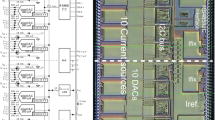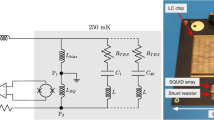Abstract
SiGe integrated circuits dedicated to the readout of superconducting bolometer arrays for astrophysics have been developed since more than 10 years at APC. Whether for Cosmic Microwave Background (CMB) observations with the QUBIC ground-based experiment (Aumont et al. in astro-ph.IM, 2016. arXiv:1609.04372) or for the Hot and Energetic Universe science theme with the X-IFU instrument on-board of the ATHENA space mission (Barret et al. in SPIE 9905, space telescopes & instrumentation 2016: UV to \(\gamma \)Ray, 2016. https://doi.org/10.1117/12.2232432), several kinds of Transition Edge Sensor (TES) (Irwin and Hilton, in ENSS (ed) Cryogenic particle detection, Springer, Berlin, 2005) arrays have been investigated. To readout such superconducting detector arrays, we use time or frequency domain multiplexers (TDM, FDM) (Prêle in JINST 10:C08015, 2016. https://doi.org/10.1088/1748-0221/10/08/C08015) with Superconducting QUantum Interference Devices (SQUID). In addition to the SQUID devices, low-noise biasing and amplification are needed. These last functions can be obtained by using BiCMOS SiGe technology in an Application Specific Integrated Circuit (ASIC). ASIC technology allows integration of highly optimised circuits specifically designed for a unique application. Moreover, we could reach very low-noise and wide band amplification using SiGe bipolar transistor either at room or cryogenic temperatures (Cressler in J Phys IV 04(C6):C6-101, 1994. https://doi.org/10.1051/jp4:1994616). This paper discusses the use of SiGe integrated circuits for SQUID/TES readout and gives an update of the last developments dedicated to the QUBIC telescope and to the X-IFU instrument. Both ASIC called SQmux128 and AwaXe are described showing the interest of such SiGe technology for SQUID multiplexer controls.






Similar content being viewed by others
Notes
e.g. TDM sequencing or decoding serial bus for adjusting current sources
differential structure rejects common mode noise
the optimal noise is reached when the \(i_n = \sqrt{2 \times 2qI_\mathrm{B}}\) equals \(e_n\) divided by the SQUID output impedance (not discussed here). Under this condition, the total input noise is \(\sqrt{2} \times e_n\)
including contact and silicon resistances linking the buried active region
it is the largest multiplexing factor ever demonstrated, thanks to two multiplexing stages
The 1/f noise automatically decreases because of the larger white noise. A strong reduction of the temperature dependencies of parameters as the \(\beta \) and \(g_\mathrm{m}\) may have an additional impact.
References
J. Aumont et al., astro-ph.IM (2016). arXiv:1609.04372
D. Barret et al., in SPIE 9905, Space Telescopes & Instrumentation 2016: UV to \(\gamma \) Ray, 99052F (2016). https://doi.org/10.1117/12.2232432
K.D. Irwin, G.C. Hilton, Transition-Edge Sensors, in Cryogenic Particle Detection, Topics in Applied Physics, vol 99, ed. by C. Enss (Springer, Berlin, 2005), pp. 63–149
D. Prêle, JINST 10, C08015 (2015). https://doi.org/10.1088/1748-0221/10/08/C08015
J. Cressler, J. Phys. IV 4(C6), C6-101 (1994). https://doi.org/10.1051/jp4:1994616
D. Prêle et al., IEEE TAS 26, 1–5 (2016). https://doi.org/10.1109/TASC.2015.2510606
J.D. Cressler, Extreme Environment Electronics Ch18 (2012). https://doi.org/10.1201/b13001-23
H.K. Gummel, H.C. Poom, Bell Syst. Tech. J. 49(5), 827–852 (1970). https://doi.org/10.1002/j.1538-7305.1970.tb01803.x
C.C. Hu, Modern Semiconductor Devices for Integrated Circuits, Ch8.2.1 and 8.4.4, ISBN 10: 0136085253 (2010)
D. Prêle et al., JLTP 184, 363–368 (2016). https://doi.org/10.1007/s10909-015-1449-9
K.D. Irwin, AIP Conf. Proc. 1185(229), 229–236 (2009). https://doi.org/10.1063/1.3292320
D. Prêle et al., JATIS 2, 046002 (2016). https://doi.org/10.1117/1.JATIS.2.4.046002
Acknowledgements
The authors would like to thank the anonymous reviewers for their valuable comments and suggestions to improve the quality of the paper. This work is supported by the CNES and CNRS.
Author information
Authors and Affiliations
Corresponding author
Rights and permissions
About this article
Cite this article
Prêle, D., Voisin, F., Beillimaz, C. et al. SiGe Integrated Circuit Developments for SQUID/TES Readout. J Low Temp Phys 193, 455–461 (2018). https://doi.org/10.1007/s10909-018-1886-3
Received:
Accepted:
Published:
Issue Date:
DOI: https://doi.org/10.1007/s10909-018-1886-3




